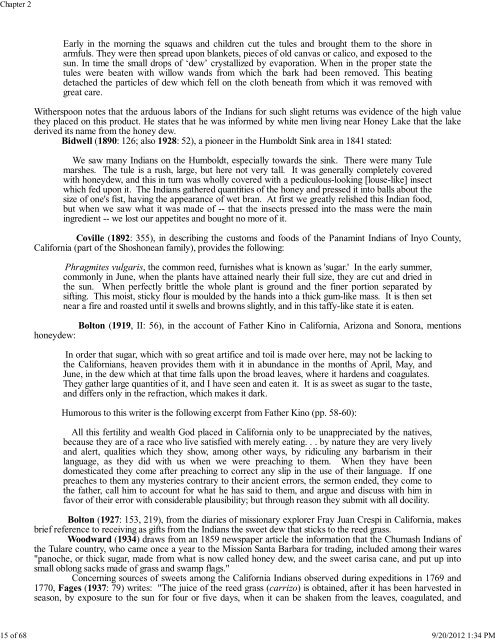Chapter 2. Insect Foods of North American Indigenous Populations ...
Chapter 2. Insect Foods of North American Indigenous Populations ...
Chapter 2. Insect Foods of North American Indigenous Populations ...
You also want an ePaper? Increase the reach of your titles
YUMPU automatically turns print PDFs into web optimized ePapers that Google loves.
<strong>Chapter</strong> 215 <strong>of</strong> 68 9/20/2012 1:34 PMEarly in the morning the squaws and children cut the tules and brought them to the shore inarmfuls. They were then spread upon blankets, pieces <strong>of</strong> old canvas or calico, and exposed to thesun. In time the small drops <strong>of</strong> ‘dew’ crystallized by evaporation. When in the proper state thetules were beaten with willow wands from which the bark had been removed. This beatingdetached the particles <strong>of</strong> dew which fell on the cloth beneath from which it was removed withgreat care.Witherspoon notes that the arduous labors <strong>of</strong> the Indians for such slight returns was evidence <strong>of</strong> the high valuethey placed on this product. He states that he was informed by white men living near Honey Lake that the lakederived its name from the honey dew.Bidwell (1890: 126; also 1928: 52), a pioneer in the Humboldt Sink area in 1841 stated:We saw many Indians on the Humboldt, especially towards the sink. There were many Tulemarshes. The tule is a rush, large, but here not very tall. It was generally completely coveredwith honeydew, and this in turn was wholly covered with a pediculous-looking [louse-like] insectwhich fed upon it. The Indians gathered quantities <strong>of</strong> the honey and pressed it into balls about thesize <strong>of</strong> one's fist, having the appearance <strong>of</strong> wet bran. At first we greatly relished this Indian food,but when we saw what it was made <strong>of</strong> -- that the insects pressed into the mass were the mainingredient -- we lost our appetites and bought no more <strong>of</strong> it.Coville (1892: 355), in describing the customs and foods <strong>of</strong> the Panamint Indians <strong>of</strong> Inyo County,California (part <strong>of</strong> the Shoshonean family), provides the following:Phragmites vulgaris, the common reed, furnishes what is known as 'sugar.' In the early summer,commonly in June, when the plants have attained nearly their full size, they are cut and dried inthe sun. When perfectly brittle the whole plant is ground and the finer portion separated bysifting. This moist, sticky flour is moulded by the hands into a thick gum-like mass. It is then setnear a fire and roasted until it swells and browns slightly, and in this taffy-like state it is eaten.Bolton (1919, II: 56), in the account <strong>of</strong> Father Kino in California, Arizona and Sonora, mentionshoneydew:In order that sugar, which with so great artifice and toil is made over here, may not be lacking tothe Californians, heaven provides them with it in abundance in the months <strong>of</strong> April, May, andJune, in the dew which at that time falls upon the broad leaves, where it hardens and coagulates.They gather large quantities <strong>of</strong> it, and I have seen and eaten it. It is as sweet as sugar to the taste,and differs only in the refraction, which makes it dark.Humorous to this writer is the following excerpt from Father Kino (pp. 58-60):All this fertility and wealth God placed in California only to be unappreciated by the natives,because they are <strong>of</strong> a race who live satisfied with merely eating. . . by nature they are very livelyand alert, qualities which they show, among other ways, by ridiculing any barbarism in theirlanguage, as they did with us when we were preaching to them. When they have beendomesticated they come after preaching to correct any slip in the use <strong>of</strong> their language. If onepreaches to them any mysteries contrary to their ancient errors, the sermon ended, they come tothe father, call him to account for what he has said to them, and argue and discuss with him infavor <strong>of</strong> their error with considerable plausibility; but through reason they submit with all docility.Bolton (1927: 153, 219), from the diaries <strong>of</strong> missionary explorer Fray Juan Crespi in California, makesbrief reference to receiving as gifts from the Indians the sweet dew that sticks to the reed grass.Woodward (1934) draws from an 1859 newspaper article the information that the Chumash Indians <strong>of</strong>the Tulare country, who came once a year to the Mission Santa Barbara for trading, included among their wares"panoche, or thick sugar, made from what is now called honey dew, and the sweet carisa cane, and put up intosmall oblong sacks made <strong>of</strong> grass and swamp flags."Concerning sources <strong>of</strong> sweets among the California Indians observed during expeditions in 1769 and1770, Fages (1937: 79) writes: "The juice <strong>of</strong> the reed grass (carrizo) is obtained, after it has been harvested inseason, by exposure to the sun for four or five days, when it can be shaken from the leaves, coagulated, and
















